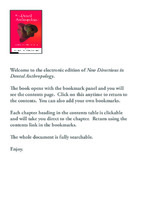New Directions in Dental Anthropology: Paradigms, methodologies and outcomes
Contributor(s)
Townsend, Grant (editor)
Kanazawa, Eisaku (editor)
Takayama, Hiroshi (editor)
Language
EnglishAbstract
This book contains papers arising from a symposium held during a combined meeting of The International Union of Anthropological and Ethnological Sciences (IUAES), The Australian Anthropological Society (AAS) and The Association of Social Anthropologists of Aotearoa New Zealand at the University of Western Australia from July 5-8th, 2011. It follows on from a recently published Special Issue Supplement of Archives of Oral Biology, Volume 54, December 2009 that contains papers from an International Workshop on Oral Growth and Development held in Liverpool in 2007 and edited by Professor Alan Brook. Together, these two publications provide a comprehensive overview of state-of-the-art approaches to study dental development and variation, and open up opportunities for future collaborative research initiatives, a key aim of the International Collaborating Network in Oro-facial Genetics and Development that was founded in Liverpool in 2007.
The aim of the symposium held at The University of Western Australia in 2011 was to emphasise some of the powerful new strategies offered by the science of dental anthropology to elucidate the historical lineage of human groups and also to reconstruct environmental factors that have acted on the teeth by analysing dental morphological features. In recent years, migration, as well as increases and decreases in the size of different human populations, have been evident as a result of globalisation. Dental features are also changing associated with changes in nutritional status, different economic or social circumstances, and intermarriage between peoples. Dental anthropological studies have explored these changes with the use of advanced techniques and refined methodologies. New paradigms are also evolving in the field of dental anthropology.
When considered together with the recent special issue of Archives of Oral Biology that highlighted the importance of research approaches focused at both the molecular and phenotypic levels, it is clear that we have now reached a very exciting stage in our ability to address key questions and issues about the normal and abnormal development of the dentition, as well as the diseases that commonly affect our teeth and gums.
Keywords
moca; non-metric dental characteristics; eisaku kanazawa; hiroshi takayama; mandibular canines; dentition; sex determination; study of twins; arch size; main occluding area; genes for teeth; maxillary canines; molar reduction; dental anthropology; grant townsend; primary tooth emergence; dental crown size; sexual dimorphism; tooth wear assessment; australian aboriginals; tooth wear analysis; Anatomical terms of location; Cusp (anatomy)DOI
10.1017/9780987171870ISBN
9780987171870OCN
797158965Publisher
University of Adelaide PressPublisher website
https://www.adelaide.edu.au/press/Publication date and place
2012Classification
Anthropology
Dentistry


 Download
Download Web Shop
Web Shop